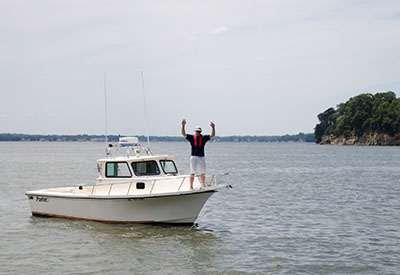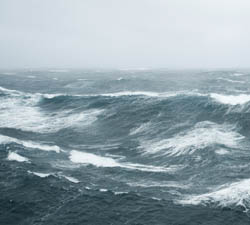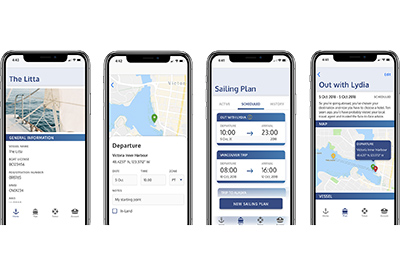Don’t Go Out Unless You Can Get Back In – Reboarding Ladders
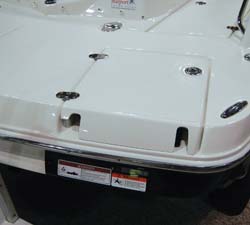
By Andy Adams
 It’s been a long time since I went for an unexpected swim, but it’s happened to me before and it will probably happen again.
It’s been a long time since I went for an unexpected swim, but it’s happened to me before and it will probably happen again.
While losing your balance and hitting the water is bad (really bad if you are carrying an arm load of valuable things), clearly there should be an expectation that this may happen and every boat builder should aptly equip their boats to facilitate reboarding by a person who has fallen overboard.
It’s only common sense, but sometimes common sense is in short supply.
In the American Boat and Yacht Council (ABYC) Standards, in section 41.9.1, it clearly states that a, “Means of unassisted reboarding shall be provided on all boats, and must be accessible to, or deployable by, the person in the water.”
The American Boat & Yacht Council was formed by members of the Motorboat and Yacht Advisory Panel of the U.S. Coast Guard’s Merchant Marine Council back on February 1, 1954, in New York State as a not-for-profit corporation.
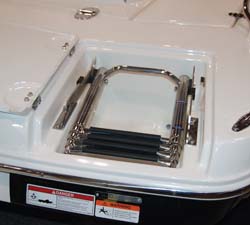 The group’s goal was to develop safety standards for the design, construction, repair and maintenance of recreational boats. The mission of ABYC is to improve boating safety and reduce the number of injuries and fatalities that occur as a result of improper design or maintenance.
The group’s goal was to develop safety standards for the design, construction, repair and maintenance of recreational boats. The mission of ABYC is to improve boating safety and reduce the number of injuries and fatalities that occur as a result of improper design or maintenance.
Re-stated in more specific terms, the Council’s mission is to develop quality technical practices and engineering standards for the design, construction, maintenance and repair of small craft with reference to their safety. That means guidelines – not laws or regulations.
That is why many boats, even ones from very good builders, may not follow the ABYC Standards. Now, in my opinion, not to have a means of unassisted reboarding that is accessible to, or deployable by, the person in the water, is bad. Unsafe. Stupid.
Builders may argue that there are costs to this, that such ladders or reboarding devices are not attractive, or don’t fit with a boat’s styling…but I see all that as just excuses.
Remember the days when people refused to wear car seatbelts? People used to say, “Not me! I won’t wear a seatbelt. I want to be thrown clear of the crash!”
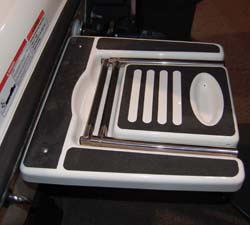 OK – it’s maybe not a crash, but it is a splash and accidents do happen.
OK – it’s maybe not a crash, but it is a splash and accidents do happen.
So, back to the ABYC Standards. Part of the Council’s recommendations is that “The top surface of the lowest step of a reboarding ladder, if installed to meet the requirement of this standard, shall be at least 12 inches (305mm) below the waterline with the boat in the static floating position.”
If the person in the water can’t actually get a leg up on the ladder, it is useless.
Recently, I attended a trade show for boat builders and a company called Garelick was showing their EEZ-IN II Ladders. I had not seen one before and they emphasize it is for OEM use; you can’t retrofit one but depending on the boat, I bet you could. The EEZ-IN II integrated transom ladder is completely hidden from view when not in use.
When needed, the ladder unlocks and slides aft and into the water in one fluid motion. This unique combination of stowability and simplicity provides boaters quick, easy, and safe reboarding with no on board assistance required.
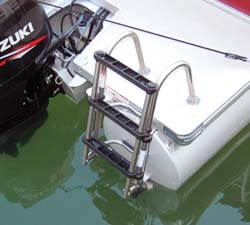 The ladder is a dive-type design with the steps folding down from a central post like branches on a tree. The ladder is housed on a tube installed inside the boat, under the floor. When you pull the ladder out, it drops down and folds out, ready for use. It’s really an emergency device although you could use it whenever you want.
The ladder is a dive-type design with the steps folding down from a central post like branches on a tree. The ladder is housed on a tube installed inside the boat, under the floor. When you pull the ladder out, it drops down and folds out, ready for use. It’s really an emergency device although you could use it whenever you want.
Regardless of the design of the boat and any general ladder it may have, I would advocate to see an emergency reboarding ladder as standard equipment – like seatbelts.
Without that, you can’t always access a ladder, even on boats that have them. I have already mentioned Garelick but there are many others.: Attwood, Davis, Doyle, Plastimo to name a few. See your dealer if you don’t already have a ladder.
If you do have a ladder on your boat (and many do), let’s start by first ensuring that your dinghy, or other accessories are not blocking the ladder. We have seen many ladders carefully covered by a fibreglass lid or other means of keeping a top-mounted ladder from being a toe-stubber.
Next, there are designs that mount under the swim platform. Check to be sure a person in the water can deploy it but I suspect you can fit this type of ladder easily to many boats.
 If you have a ladder that can be reached, make sure there isn’t a latch that is out of reach. You can’t drive along dragging a ladder, so most have a means of securing the ladder in the “up” position. I like the idea of a rubber C-clip that holds through friction but that can be pulled down.
If you have a ladder that can be reached, make sure there isn’t a latch that is out of reach. You can’t drive along dragging a ladder, so most have a means of securing the ladder in the “up” position. I like the idea of a rubber C-clip that holds through friction but that can be pulled down.
I’m confident that your marine dealer can find a great solution for your boat, whether you have a sailboat or a powerboat. Sailboats are really scary because the hull is generally so smooth there’s nothing anywhere even to use as a handhold. It may take a creative approach to get that ladder installed but it’s worth a million if you ever need it.
Once you’ve purchased your new reboarding ladder, you’ll need to practise using it. Reboarding success is all about technique. Take your boat out on a warm day and practice boarding with your ladder so you know what to expect should the unexpected occur.
Then, try to remember that it’s there and as part of your regular safety check (when any guests or family members join you to go boating) when you are showing them where PFDs are stowed, how the basic controls work and the rest of your safety drill, give them a complete explanation of how the ladder works and how to reboard.
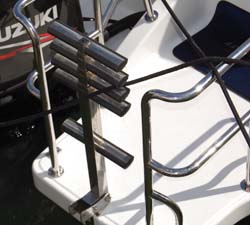 If you can’t reach it from the water, you won’t be able to use it, and you may not be able to get back in the boat at all. So, this summer, make sure that you address this issue and never let a wet deck or loose shoelace turn your day into a disaster.
If you can’t reach it from the water, you won’t be able to use it, and you may not be able to get back in the boat at all. So, this summer, make sure that you address this issue and never let a wet deck or loose shoelace turn your day into a disaster.
Photo Captions:
Photo 1 – This nice swim area has recessed cleats and a cover over the boarding ladder so nobody stubs their toe. However, could a person in the water access the ladder?
Photo 2 – Here is the four-step boarding ladder with the fibreglass cover flipped open. I can’t believe anybody could flip the cover out of the way if they were struggling in cold water.
Photo 3 – This outboard runabout has a simple swim platform and just a little ladder but I bet you could reach the ladder from the water and get back on board.
Photo 4 – This pontoon boat has a ladder that is held up by a pair of rubber C-clips. A person in the water could almost certainly swing it down.
Photo 5 – This boat has a great ladder that extends out at a comfortable angle and is well braced. The concern here is that it secured by a pair of Velcro straps. There’s no hope that a person in the water could undo the Velcro.
Photo 6 – This is an outstanding ladder design that you can even climb wearing swim fins. As it swings down, it extends well into the water. A person in the water can deploy this by pulling out the locking pin but they would have to understand how it works.

